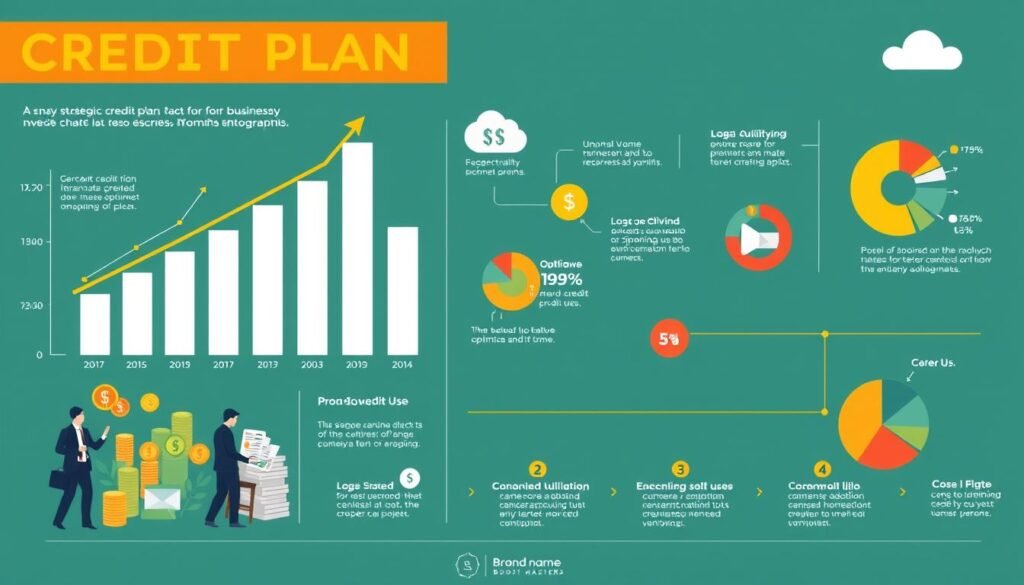
Is your business missing out on growth because of bad credit management? Many entrepreneurs don’t use credit smartly, missing out on chances. Let’s see how using credit well can help your business grow and succeed financially.
Using credit wisely can change the game for your business. It’s not just about getting money; it’s about using it to grow. With good credit management, you can keep your business running smoothly, invest in new opportunities, and build a strong financial base.
Being financially disciplined is crucial for credit use. A good credit history not only boosts your credit score but also opens up better loan terms. This can help you grow your market share and increase your revenue, giving you an edge over competitors.
Effective credit use is more than just borrowing money. It’s about making smart choices, linking credit to income, and teaching your team to be financially responsible. This way, you’re setting your business up for lasting growth and success.
Key Takeaways
- Strategic credit use can stabilize operations and fuel business growth
- Positive credit history leads to better financing terms
- Diversify credit types to strengthen overall creditworthiness
- Regularly monitor credit to track progress and resolve issues
- Align credit usage with revenue-generating activities
- Educate employees on responsible credit management
- Aim for a credit utilization ratio of around 30%
Understanding Credit and Its Importance for Businesses
Credit is crucial for business growth and success. It helps with expansion, smooth cash flow, and new opportunities. Let’s explore the importance of business credit for entrepreneurs.
What is Business Credit?
Business credit lets your company borrow money. It’s different from personal credit and is key for financing. A good credit score means better loan terms and higher limits, offering more financial freedom.

Types of Business Credit Available
There are many types of business credit:
- Business lines of credit for flexible funding
- Term loans for larger projects
- Business credit cards for short-term expenses
Each type meets different financing needs. For example, a line of credit helps with cash flow during slow times or unexpected costs.
The Role of Credit in Business Growth
Credit drives business growth. It lets you:
- Invest in new equipment or technology
- Expand your operations or physical space
- Hire and train new employees
- Launch marketing campaigns
Good debt use speeds up growth. For example, tech startups use venture debt to grow fast. Real estate developers use loans for property purchases and renovations.
“Properly managed credit can be a potent tool for entrepreneurship, enabling business start-up or expansion.”
Responsible credit management is essential. Pay bills on time, keep a healthy debt ratio, and build strong lender relationships. This way, you get the most from business credit while avoiding risks.
Evaluating Your Current Credit Situation
Knowing your business credit score is key for managing finances well and avoiding risks. Regularly checking your credit helps you make smart choices for your business’s growth.
Analyzing Credit Reports
Credit reports give a full picture of your business’s financial health. Look at these reports every year to find mistakes that could hurt your score. Not all lenders report to all three credit bureaus, which can affect your score.

Assessing Your Business Credit Score
Your credit score, from 300 to 850, shows how risky you are as a borrower. Try to use less than 30% of your credit limit. Paying bills on time is also very important for a good score. Keep these points in mind:
- Payment history
- Credit utilization ratio
- Length of credit history
- Types of credit accounts
- Recent credit inquiries
Common Credit Pitfalls to Avoid
Watch out for these common mistakes in credit management:
| Pitfall | Impact | Mitigation Strategy |
|---|---|---|
| Late payments | Can damage credit score for up to 7 years | Set up automatic payments or reminders |
| High credit utilization | Indicates over-reliance on borrowed funds | Keep utilization below 30% of total limit |
| Multiple hard inquiries | Suggests being “high risk” | Limit new credit applications |
By steering clear of these mistakes and using good credit management, you can boost your business’s financial health and credit score.
Creating a Strategic Credit Plan
A good credit plan is key for business growth. It helps set financial goals and manage debt. This way, you can use credit to grow your company.

Setting Financial Goals
First, define your business goals. Do you want to increase sales, enter new markets, or buy new equipment? Your goals will help you decide how to use credit.
For example, if you want to raise sales by 20% this year, you might use credit for marketing or to buy more stock.
Budgeting for Debt Repayment
Managing debt well is important for good credit. Make a budget that focuses on making payments on time. You could offer a 5% discount for early payments to improve cash flow.
Also, keep your credit card balance low, below 50% of the limit. This helps you manage your spending.
Leveraging Credit for Investment
Use credit wisely to fund growth. Business credit cards have higher limits than personal ones, great for big purchases. Loans for equipment can help buy what you need without using all your cash.
Remember, all fees and interest on business credit cards are tax-deductible if used for business.
By linking your credit use to your business goals, you can build a strong growth strategy. Always compare financing options and think about how they’ll affect your credit score in the long run.
Utilizing Credit for Business Expansion
Credit is key for growing your business. It opens doors to new chances and helps you grow bigger. A smart financing plan lets you access funds you might not have had before.
Financing New Projects
A business line of credit is great for new projects. It’s like a revolving loan that lets you use funds as needed. This way, you can invest in new ideas and not rely on just one source of money.

Hiring and Training Employees
Adding more staff is important for growth. Credit helps with cash flow, so you can pay employees and train them. This boosts productivity and innovation, moving your business forward.
Purchasing Equipment and Technology
Keeping up with the latest tech and equipment is vital. Credit lets you buy what you need without using all your cash. This way, you can manage your inventory better and save money on each item.
| Credit Use | Business Impact |
|---|---|
| Financing New Projects | Diversification of revenue streams |
| Hiring and Training | Increased productivity and innovation |
| Equipment Purchases | Enhanced operational efficiency |
Using credit wisely means keeping an eye on how much you use and keeping your credit score up. This way, you get better terms and lower interest rates, helping your business grow over time.
Credit Management Best Practices
Smart credit management is key for business financial health. By learning important practices, you can raise your credit score and find new growth chances. Let’s look at ways to improve your credit management and strengthen your finances.
Paying Bills on Time
On-time bill payments are essential for a good credit score. Use automatic payments or reminders to avoid late fees. Remember, your payment history is 35% of your score. Regular payments can greatly improve your creditworthiness.
Maintaining a Healthy Credit Utilization Ratio
Your credit utilization ratio is crucial for managing debt. Keep your credit card balances under 30% of your limit. This shows lenders you handle credit well and can boost your score.
Building Strong Relationships with Lenders
Good relationships with lenders can lead to better terms and more financial freedom. Talk openly with your lenders if you’re facing payment issues. Many are ready to help find solutions that work for both sides.
“Good credit management is about more than just numbers. It’s about building trust and demonstrating reliability to your financial partners.”
By following these credit management tips, you’ll be on the path to financial stability. This opens doors to new opportunities for your business.
Understanding Interest Rates and Fees
Interest rates and fees are key in your financing strategy. They greatly affect your business growth and how well you can handle debt. Let’s explore the important parts of interest rates and fees for startup lines of credit.
The Impact of Interest on Business Growth
Interest rates for startup lines of credit vary from 8% to 24% APR. This big range can really change your costs. Secured lines usually have lower rates, 8-13%, while unsecured ones might be 12-20%.
Comparing Lender Offers
When looking at lender offers, think about these things:
- Credit limits (usually $10,000 to $100,000 at first)
- Introductory fixed rates (some offer these for the first 6-12 months)
- Repayment terms (often interest-only for 6-12 months, then 2-3% of balance)
- Draw period (usually 12-24 months for borrowing again)
Strategies for Securing Lower Rates
To get lower rates and reduce risks:
- Improve your credit score (using credit wisely can raise it by 50-100 points)
- Choose secured credit lines when you can
- Keep your credit utilization ratio under 30%
- Look at offers from different lenders
| Credit Type | Typical Interest Rate | Credit Limit Range |
|---|---|---|
| Secured Business Line | 8-13% APR | $10,000 – $75,000 |
| Unsecured Business Line | 12-20% APR | $10,000 – $75,000 |
| Venture Debt Line | Varies | $200,000 – $1,000,000 |
Knowing these details helps you make smart choices about your financing. It also helps you manage your debt better.
Leveraging Credit for Marketing and Customer Acquisition
Smart businesses use credit wisely to grow. It becomes a strong financing strategy. By using credit for marketing and getting new customers, you can increase your company’s reach and earnings.
Using Credit for Advertising Campaigns
Credit can boost your ads, helping you find new customers. With most U.S. businesses being small, it’s key to stand out. Growth capital for ads can make your business more visible and draw in new clients.
- Invest in digital marketing platforms
- Create compelling content for social media
- Run targeted email campaigns
- Optimize your website for search engines
Financing Customer Incentives and Promotions
Credit also powers customer incentives and promotions. These can help you stand out and keep customers coming back.
| Promotion Type | Potential ROI | Customer Impact |
|---|---|---|
| Loyalty Programs | 25-95% | High retention |
| Referral Bonuses | 30-70% | New customer growth |
| First-Time Buyer Discounts | 15-40% | Increased conversion |
While credit can help grow your business, keep your financial leverage ratio below 1. This ensures stability. With smart credit use, you can see up to 40% return on investment, moving your business forward.
Smart credit use isn’t just about borrowing; it’s about investing in your business’s future and customer relationships.
Preparing for Economic Uncertainties
Economic ups and downs can really hurt businesses. Smart business owners focus on risk management and staying financially disciplined. Let’s look at how to create a safety net and adjust your credit strategy during tough times.
Building an Emergency Fund with Credit
Having a financial cushion is key for business stability. Experts say to save three to six months of expenses. Using credit smartly can help build this fund.
Think about a low-interest line of credit to save money slowly. This way, you can keep your cash flow good and still have a safety net.
Adjusting Your Credit Strategy During Downturns
When the economy slows down, it’s time to change your credit strategy. Try to use less credit and talk to lenders about better terms. The Federal Reserve’s rate cut gives businesses a chance to get better rates.
Also, diversify your income and use digital tools to save money. This helps you stay efficient and cut costs.
Remember, being financially smart is crucial in uncertain times. Avoid big purchases, watch your spending, and manage high-interest debt well. By being flexible with credit, you can face economic challenges and grow your business.
Case Studies: Success Stories of Credit Use
Real-world examples show how using credit wisely can lead to great success. Let’s look at some inspiring stories. We’ll learn valuable lessons for entrepreneurs wanting to use credit for their ventures.
Small Business Successes
A local bakery owner used a business credit card to manage cash flow and track expenses. By using the card’s rewards program, they earned points to fund a marketing campaign. This campaign boosted sales by 30%.
This smart approach to credit management improved their finances and gave a big return on investment.
Lessons from Larger Corporations
Larger companies show the power of credit as growth capital. For example, a tech firm used a business line of credit for research and development. This led to a groundbreaking product that doubled their market share.
This shows how smart credit use can fuel innovation and drive big business growth.
Key Takeaways for Entrepreneurs
For entrepreneurs wanting to succeed, keeping a high credit score is key. Regular, responsible use of business credit cards can build a strong credit history. This can lead to access to bigger loans in the future.
When picking a credit card, look at interest rates, fees, and rewards. Smart credit use is more than just getting funds. It’s a tool for strategic growth and financial management.


